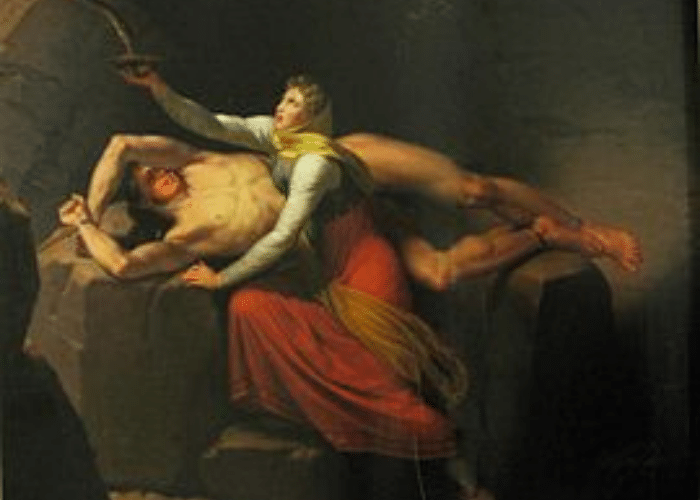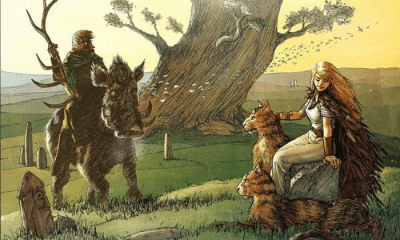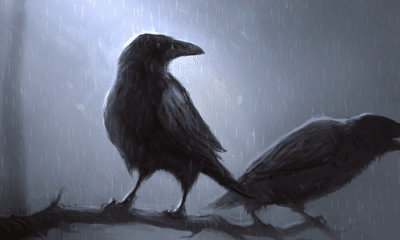
Norse
Sigyn: Loki’s Faithful Wife
Sigyn: Loki’s Faithful Wife
Loki’s wife is mentioned in only one story from Norse mythology, but her single appearance is an important one!
Table of Contents
For this crime, Loki is punished harshly. He is bound with his own son’s entrails to have a snake drip poison into his face for all time.
The Norse believed that Loki would escape on the eve of Ragnarök, but until then only one thing would ease the suffering of his imprisonment.
His faithful wife, Sigyn, remained by his side to keep the poison off his face. While she could never completely spare him from pain, she devoted her life to making him as comfortable as possible.
Through the ages Sigyn has been interpreted as a figure of both tragic romanticism and extreme virtue.
Sigyn and the Bowl of Poison
While Loki plays a major role in many Norse myths, his wife Sigyn is mentioned much less frequently.
Even with sparse attestation, it can be inferred the Sigyn was a known character before the Prose Edda and Poetic Edda were written in a later era. She is mentioned in at least one 9th century poem and appears in art, including England’s Gosford Cross.
In all of these depictions, however, the same scene is shown. This is the binding of Loki.
According to legend, the trickster was once a friend to Odin and the Aesir gods. While his mischief often caused problems, he also helped the gods on many occasions and brought them fabulous gifts.
Over time, however, the relationship became more antagonistic. Loki’s actions became deliberately cruel and the gods grew angry with him.
The friendship was forever destroyed when Loki caused the death of Baldr, the most well-loved of the Aesir. Not only had he tricked Baldr’s blind bother, Höð, into hitting him with the only material that could possibly hurt him, but Loki had also deliberately kept Baldr from being released from Hel.
The gods swore vengeance and hunted for Loki. Although he tried to use his usual tricks and shapeshifting to hide, he was soon captured.
Loki and his sons were dragged to a remote cave where he would face his punishment.
His son Váli was turned into a ferocious wolf. He attacked his brother, whose name is given as either Nari or Narfi, and tears him to pieces.
After Narfi’s death, the Aesir gods gathered up his entrails. They pushed Loki down onto three large stones and threw his son’s entrails over him, using magic to make them stronger than iron.
Loki was imprisoned, but for one jötunn this was not enough.
Skaði’s father had been killed as a result of one of Loki’s tricks. She had married Njord as payment, but the couple had turned out to be poorly matched and extremely unhappy.
Skaði saw Loki’s binding as a chance to finally get revenge for her father’s death. Once he was bound, she placed a large snake above his head.
The snake dripped burning venom into Loki’s face. He shook and writhed in pain but the binding the gods had made kept him in place.
Loki’s wife, Sigyn rushed to his side with a bowl. She knelt beside him, holding the bowl over his face to catch the snake’s venom before it could burn him.
When the bowl filled, however, Sigyn had to leave the cave to empty it. Whenever this happened the venom hit Loki again and he writhed so terribly that the entire earth shook.
Some later retellings of the story added that Loki grew angry with Sigyn whenever she left to empty the bowl. Despite this, however, she never left his side or let a single drop of venom fall into his face when she was there.
This cycle will continue, the Norse sources say, until Loki breaks free before Ragnarök. Until then, Sigyn will stay at his side to spare him as much pain as she can.
My Modern Interpretation
The image of Sigyn protecting her husband’s face is a tragic one.
Having lost both of her sons, the character is now bound to the endless and thankless task of protecting her husband. While she is diligent, she cannot completely spare him from pain.
In early medieval culture, however, Sigyn could also be considered a character of exceptional virtue.
Faithfulness and devotion were among the chief virtues of a wife in the Viking Age and the Middle Ages. Of all the characters in Norse mythology, Sigyn perhaps embodies these virtues most fully.
Given Loki’s actions in earlier myths, few people would fault Sigyn for refusing to help him. This is especially true since his crimes led to the violent deaths of her two sons.
Sigyn, however, does not hesitate to be of service to her husband. Despite his sins, she remains absolutely loyal.
Even in later versions of the story in which he berates her, Sigyn remains loyal.
The character does not even speak. She does not complain about her lot or try to bargain for her husband’s freedom and her son’s lives. She simply goes about her work and does what she can to help Loki.
Sigyn’s virtues of devotion, service, and fidelity are depicted to such an extent and under such extreme circumstances that they seem almost absurd.
Artists of the German Renaissance saw Sigyn as a tragically romantic figure, but modern readers are more likely to see Loki’s wife as a victim.
A feminist interpretation would assert that Sigyn is a victim of the expectations placed on a wife. She is dutiful and subservient to such an extent that she endures Loki’s torture alongside him although she has committed no crime.
A broader view of the story would be that Sigyn, like the other characters named in the scene, is a casualty of Loki’s treachery.
Most written legends do not specify which gods bind Loki, instead simply naming the Aesir as a group. The named characters, other than Loki, are Sigyn, Narfi, Váli, and Skaði.
None of these characters committed any crime. In fact, Skaði is the only one of the four that is mentioned outside of this story.
Because of Loki, however, Skaði lost her father and entered into an unhappy marriage.
Narfi was violently killed and Váli turned into a wolf for no reason other than to make Loki suffer their deaths and keep them from possibly avenging him.
Sigyn, meanwhile, is sentenced to spend eternity in service to her husband. Because of his crimes she loses her children and, because she stays by his side, her freedom.
The story of Sigyn may show an extreme version of marital devotion, but it also shows the widespread effects of one person’s crimes. Innocent people like Sigyn can have their lives destroyed as well.
In Summary
Loki’s wife, Sigyn, appears in just one scene in Norse mythology. Viking Age poetry and art show that, despite her limited appearances, she was not the invention of later writers.
Sigyn plays a major role in the binding of Loki. After he caused Baldr’s death, the Aesir turned on Loki and used his own son’s entrails to bind him in a cave far from Asgard.
This was already a brutal punishment, but the giantess Skaði had an additional vengeance of her own. She hung a snake over Loki’s head to constantly drip poison into his face.
The venom made the trickster scream in pain, but his wife Sigyn stayed by his side. She held up a bowl all day and night to keep the venom from burning Loki’s face.
When the bowl filled she would have to get up to empty it, so the venom again hit Loki. His writhing and shaking explained earthquakes.
Sigyn would not waiver from this task until her husband broke free at Ragnarök. Until then, she remained the epitome of devotion.
Sigyn’s unwavering faithfulness made her an embodiment of medieval ideals for married women. She was devoted, helpful, and stayed by her husband’s side at great cost to herself.
This also made her a tragic figure. Renaissance artists recognized the futility of her task, the losses she endured, and the suffering that she shared with her husband.
In a modern interpretation, the story of Sigyn and the binding of Loki can be read as an example of the way in which one person’s actions can impact many lives. Sigyn, her sons, and even Skaði are innocent figures who suffered because of Loki’s crimes.









